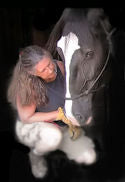Where, Oh Where, is the P3?
This is an article I wrote back in 2013 for a national publication on Equine Hooves, "The Horse's Hoof".
I thought since we've been talking about the caudal heel area of the hoof that maybe we'll go into the coffin bone. After all, that *is* a major portion of the hoof; well, THE major portion of the hoof.
The article was written for hoof trimmers but I strongly believe that owners should also have a solid knowledge of their own horses' hooves and, in that way, be able to tell if their hoofcare professional is doing an apt job or not. ...
"Determining where within the hoof capsule the distal phalanx (P3) lies is crucial in being able to properly balance the equine hoof. There is a fairly easy way to map out the hoof to estimate this with almost perfect accuracy regardless of the hoof being viewed. Pony, Standard, Draft or Mini – the hooves are basically the same with the same measurements.
The illustrations below show the landmarks to determine the placement of the P3 within the capsule of any hoof:


Illustration 1 Illustration 2
When first assessing the equine hoof for balanced trimming one needs to thoroughly clean the hoof, especially the area around the apex of the frog. In overgrown hooves, the “true apex” may be hidden under an overgrown frog apex. The frog may be trimmed back in order to reveal the actual apex of the hoof. The apex will be the deepest, most concave, spot noticeable in the sole. (Illustration 1)
Once the TRUE apex is determined then the placement of the tip of the P3 can be easily determined as well. The tip of the P3 is the landmark for determining the proper breakover of the hoof. It is at the tip of the P3 that the breakover of the hoof should be placed. If any mechanical rockering of the toe callus is to be done it is trimmed lightly from this breakover point to the distal edge of the toe at your 10⃰ or 15⃰ degree angle. As noted on illustration 1, the tip of the P3 lies approximately ¾ - 1” (or about a thumb’s width) forward of the true apex. Illustration 2 notes the P3 within the hoof capsule.
To determine the widest point of the hoof one will measure approximately ¾ - 1” back from the true apex towards the heel. At this point, within the capsule, the center of the P3 is placed around which the hoof capsule is trimmed. The widest part of the capsule is noted in the illustrations by the red lines marked along the side of the sole. If one draws a line from side to side on the hoof it will be noted that the line will fall at the ends of the bars where they blend into the sole. One can feel a slight bump at those points on the sole itself. The distance from the widest point of the sole back to the widest part of the frogs at the heel will be approximately 2/3rds the distance as from the breakover to the true apex. The heels are to be trimmed back to the widest part of the frog in order to achieve this correct ratio of 1/3:2/3.
Now that the breakover is determined and the widest part of the sole is determined the distance from the breakover to the distal edge of the hoofwall can be determined for proper A/P balance.
The distance from the breakover to the distal edge will also be approximately ¾ - 1. In over grown toes this may take you into the white line of the hoof as the white line becomes stretched with lack of wear or trimming in overgrown toes. Bringing the toes back from the top (while hoof is on the stand) to the point where the laminae is live and begins to ‘stick’ to the toe of the hoof (it will resemble parmesan cheese sticking to the hoofwall) is an accurate determination for proper toe length of that individual hoof. (Illustration 3). Red line on illustration marks angle of rasp when taking toe back. Remember – we want to bring the toe BACK and not thin the wall so be careful of the angle of your rasp. Think of a 90* angle to the wall as in a “T” angle.)
Once the toe has been brought back sufficiently, the rest of the hoof wall can also be brought back in the same manner to match the toe. Use your hairline as a guide. Trimming the toe and wall back in this manner will help to ensure a uniform thickness of wall (Michael Savoldi, “Uniform Sole Thickness”)
Savoldi_uniform_sole_thickness
Now that you’ve determined where the P3 lies within the hoof capsule and you’ve trimmed back the toes you can now set about trimming the rest of the hoof to achieve medial/lateral and anterior/posterior balance according to the individual needs of the ‘hoof-in-hand’."
PLEASE NOTE: Remember, not every hoof is the same as another. The individual "Hoof-In-Hand" must be evaluated and tended on the individual "Horse-In-Hand". This blog post is for informational purposes only. Thank you.
Building a Supportive Barefoot Community
The team at Scoot Boot believe passionately in the barefoot horse and strive to build a supportive community of barefoot horse lovers.
Find more information about using Scoot Boots here.

Gwen Santagate is the author of "10 Secrets to Healthy Hooves" . For the last 37+ years, she has maintained healthy hooves with natural trimming on thousands of horses and specialized in pathological rehabilitation hoofcare for the last 18 years. She keeps a small herd of her own equines and continues to offer consults for horses in need.
